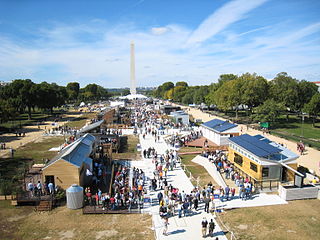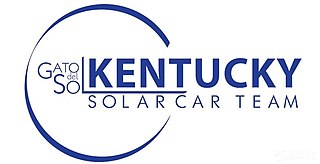
Neosho is the most populous city in Newton County, Missouri, United States, which it serves as the county seat. With a population of 12,590 as of the 2020 census, the city is a part of the Joplin, Missouri Metropolitan Statistical Area, a region with an estimated 176,849 (2011) residents. Neosho lies on the western edge of the Ozarks, in the far southwest of the state.

The World Solar Challenge (WSC), since 2013 named Bridgestone World Solar Challenge, is an international event for solar powered cars driving 3000 kilometres through the Australian outback.

John Brown University (JBU) is a private, interdenominational, Christian university in Siloam Springs, Arkansas. Founded in 1919, JBU enrolls 2,343 students from 33 states and 45 countries in its traditional undergraduate, graduate, online, and concurrent education programs.
Shell Eco-marathon is a world-wide energy efficiency competition sponsored by Shell. Participants build automotive vehicles to achieve the highest possible fuel efficiency. There are two vehicle classes within Shell Eco-marathon: Prototype and UrbanConcept. There are three energy categories within Shell Eco-marathon: battery-electric, hydrogen fuel cell, and internal combustion engine. Prizes are awarded separately for each vehicle class and energy category. The pinnacle of the competition is the Shell Eco-marathon Drivers' World Championship, where the most energy-efficient UrbanConcept vehicles compete in a race with a limited amount of energy.

The American Solar Challenge (ASC), previously known as the North American Solar Challenge and Sunrayce, is a solar car race across the United States. In the race, teams from colleges and universities throughout North America design, build, test, and race solar-powered vehicles in a long distance road rally-style event. ASC is a test of teamwork, engineering skill, and endurance that stretches across thousands of miles of public roads.

The U.S. Department of Energy (DOE) Solar Decathlon is a collegiate competition, comprising 10 contests, that challenges student teams to design and build highly efficient and innovative buildings powered by renewable energy. The winners are selected based for the best blending of design architectural and engineering excellence with innovation, market potential, building efficiency, and smart energy production. In the summer of 2018, DOE merged its two student building design competitions into one Solar Decathlon competition.

The University of Calgary Solar Car Team is a multi-disciplinary student-run solar car racing ("raycing") team at the University of Calgary, based in Calgary, Alberta, Canada. It was established to design and build a solar car to compete internationally in the American Solar Challenge (ASC) and the World Solar Challenge (WSC). The team is primarily composed of undergraduate students studying Engineering, Business, Science, Arts and Kinesiology. The mission of the University of Calgary Solar Car Team is to educate the community about sustainable energy and to serve as an interdisciplinary project through which students and faculty from various departments can collaborate in supporting sustainable energy.

Fort Crowder was a U.S. Army post located in Newton and McDonald counties in southwest Missouri, constructed and used during World War II.
Sunswift Racing is the solar car racing team of the University of New South Wales in Sydney, Australia. The team currently holds a number of world records and is best known for its participation in the World Solar Challenge (WSC). Since its founding in 1996 by Byron Kennedy, the Sunswift team has built a total of 7 cars, the most recent of which is Sunswift 7.

The University of Minnesota Solar Vehicle Project, or UMNSVP, is a team of undergraduate students from the University of Minnesota that designs and constructs solar-powered cars. In its 31 years, it has established itself as one of the world's top solar racing teams, and the top Cruiser/Multi-Occupant Vehicle team in the Western Hemisphere, with top-two finishes in eighteen of thirty-four events entered.
The Office of Energy Efficiency and Renewable Energy (EERE) is an office within the United States Department of Energy. Formed from other energy agencies after the 1973 energy crisis, EERE is led by the Assistant Secretary of Energy Efficiency and Renewable Energy, who is appointed by the president of the United States and confirmed by the U.S. Senate. Alejandro Moreno currently leads the office as the Acting Assistant Secretary.

The Midnight Sun Solar Rayce Car Team is a Canadian solar car race team affiliated with the University of Waterloo of Waterloo, Ontario. Founded in 1988, the Midnight Sun team is a student-run organization which designs and builds a solar vehicle every two to three years to compete in two solar challenges; the World Solar Challenge, held in Australia, and the American Solar Challenge, held in the United States.

The University of Kentucky Solar Car Team is an independent, student-led project that operates as part of the University of Kentucky College of Engineering. The team's primary goal is to compete in the American Solar Challenge and the Formula Sun Grand Prix over the summer, but they also perform outreach events in which they display and discuss their car with nonmembers.

Missouri University of Science and Technology is a public research university in Rolla, Missouri. It is a member institution of the University of Missouri System. Most of its 6,456 students (2023) study engineering, business, sciences, and mathematics. Known primarily for its engineering school, Missouri S&T offers degree programs in business and management systems, information science and technology, sciences, social sciences, humanities, and arts. It is classified as a "STEM-dominant", R2 doctoral university with "high research activity".

Blue Sky Solar Racing is a student-run team at the University of Toronto that designs and constructs solar powered vehicles to race in international competitions.
The Faculty of Engineering at Monash University is one of the largest engineering faculties in Australia, with over 6,700 students in 2015.
The ESET Technical School of Engineering is the school of engineering of the CEU Cardinal Herrera University, located in Alfara del Patriarca (Valencia), Spain. Currently, the ESET School occupies a former industrial building converted character with 3000m2 for effect.

The Formula Sun Grand Prix (FSGP) is an annual solar-car race that takes place on closed-loop race tracks. In the race, teams from colleges and universities throughout North America design, build, test, and race solar-powered vehicles.

James Duard Marshall was a painter, lithographer, museum director, and art conservator who lived most of his life in Kansas City. Duard [pronounced "doo-erd"] was a student of Thomas Hart Benton and is best known for his 30-foot mural created for the centennial of Neosho, Missouri in 1939. The civic leaders of Neosho had approached Benton to produce the mural, as Benton had been born in Neosho, but he suggested that his student Marshall do the job. That mural hangs in the Neosho Newton County Library.













